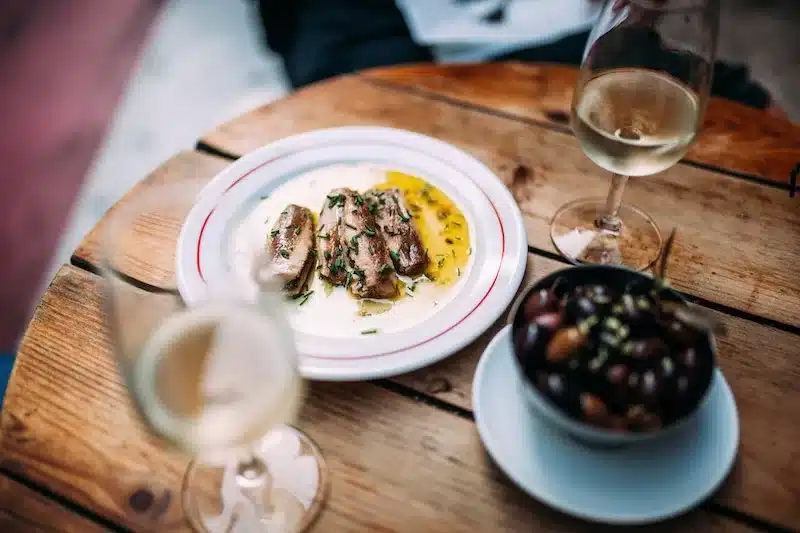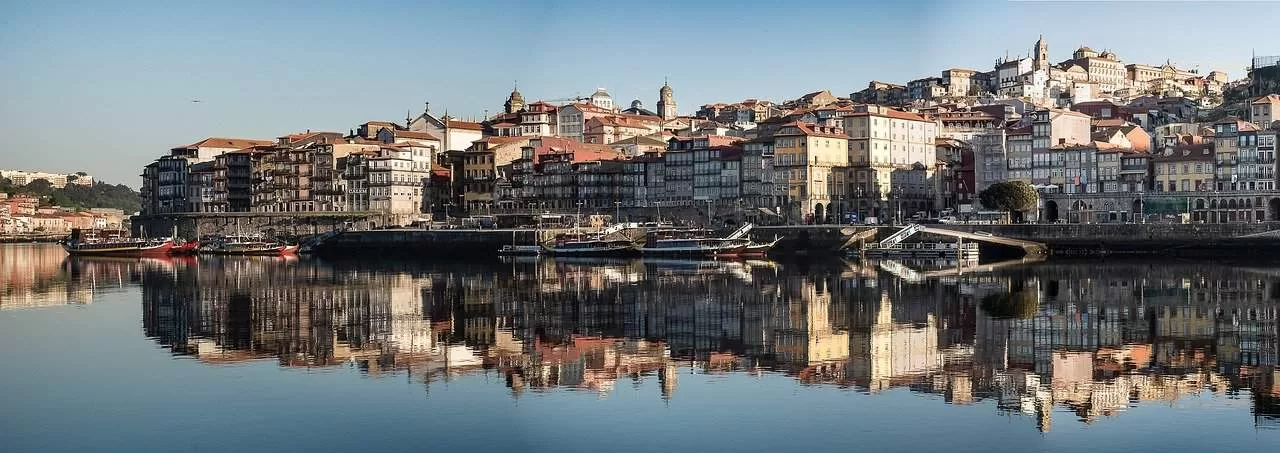Ask the Portuguese about their gastronomy, and you’ll hear a resounding response that it’s the best food in the world. Regardless of where you rank Portuguese cuisine on the global culinary stage, one thing is for sure: you’ll eat and drink well in Portugal.
The country’s long seafaring history has brought in an infusion of spices, ingredients, and global recipes. From region to region, each offering its own specialty dishes and interpretations of the classics. And with more than 250 wine varieties produced in-country, you’ll never lack a perfect pairing.
Stretching along 1,115 miles of Atlantic coastline, Portugal has abundant access to fresh seafood. While the ocean is the star of many dishes, the fertile land of the Iberian Peninsula also yields vibrant fruits and vegetables. Portuguese food is simple, soulful, and full of heart—letting the main ingredients shine.
Here are 13 essential dishes to try, listed alphabetically so you can find your favorites based on taste and curiosity. You’ll encounter them at local tascas, market stalls, contemporary wine bars, and even Michelin-starred restaurants.
#1. Ameijoas à Bulhão Pato (Clams Bulhão Pato style)
Shellfish lovers, welcome to your gastronomic heaven! Whether you’re a long-time fan or just a curious eater, Portugal is THE place to sample various types of mollusks and crustaceans, from razor clams and gooseneck barnacles to Portuguese oysters and scarlet prawns. You’ll notice that clams are prepared in diverse ways, from traditional recipes to more inventive modern gastronomic interpretations.
Out of all the variations, the Ameijoas à Bulhão Pato makes the cut. This dish features smaller and slightly sweet clams that are prepared in a traditional style, cooked with garlic, fresh cilantro, white wine, and lemon juice. It’s a light, refreshing, and delicious dish on its own. However, ordering a side of rice or French fries ensures that none of the scrumptious sauce gets left behind. Anthony Bourdain declared that “the Portuguese do clams better than anyone in the world.” Come and see for yourself!

#2. Arroz Marisco (Seafood Rice)
Who doesn’t love seafood and rice?! The Portuguese certainly do, and they serve rice in many ways, from a side dish to the main event. If you enjoy paella, risotto, and jambalaya, then Arroz Marisco (which translates to seafood rice) is definitely for you. This coastal-loving country makes the most of its delicious seafood in this soupy style rice dish! It’s a local favorite, and ingredients will vary depending on the restaurant. However, the abundance of seafood means you might get to enjoy clams, European lobsters, fresh prawns, squid, bacalhau, and more, in a flavorful rice. It’ll have you going back for bite after bite.
Read more like this: Top 5 Places To Live In Portugal
#3. Arroz de Pato (Duck Rice)
If you’re looking for a warm and hearty meal on cooler days, Arroz de Pato is what to order. This duck rice recipe originates from the Alentejo region and is a must try! Duck, rice, garlic, onions, and chorizo sausage are all cooked together. To finish the dish, it’s popped into the oven, which creates the perfect, crispy texture. The succulent shredded duck enhances the Carolina rice that’s cooked in duck stock, of course, adding to the depth of flavors. The local chorizo sausage adds a spicy element, and this dish is commonly served with orange slices, which contribute a surprising sweet and citrusy kick to this savory dish.
#4. Bacalhau (Codfish)
Although bacalhau isn’t native to Portuguese waters, it happens to be the national dish. It is said that there are over 365 ways to make bacalhau, accounting for a different variation for each day of the year, and then some. When you enter a local grocery store, the overpowering smell of salted cod will smack you straight in the nostrils. Luckily, when you dine out, you’ll get to enjoy all the goodness without the labor of soaking the fish and removing the salt.
When done right, and everyone here does it right, you’re in for a real treat. You can savor bacalhau however you most enjoy eating fish, whether that’s baked, steamed, grilled, or fried. If you’re suspicious, go with the most famous recipes before ordering an exotic rendition. Bacalhau à Brás is very popular and for good reason; the fish is served with crispy potatoes, onions, and olives, which all work perfectly together for a delicious meal full of flavor and texture. Bacalhau com natas is essentially au gratin-style, baked with cream and cheese. And, when in doubt, go for the Pastéis de Bacalhau; these bite-sized croquettes are warm, savory, and addictive.
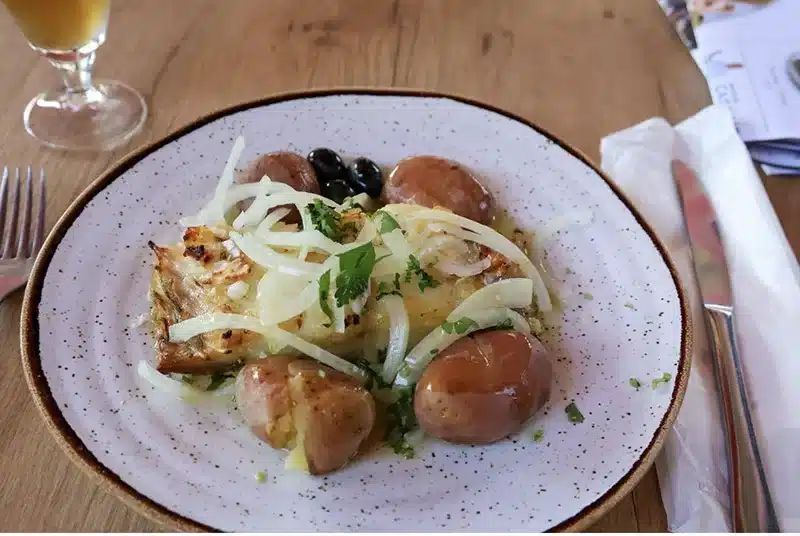
#5. Bifanas (Pork Sandwiches)
If you’re craving a hearty snack or trying to soak up some alcohol after a few too many, the Bifana’s got you covered. This simple sandwich features white bread, greasy pork, mustard, and piri-piri (hot) sauce. It’s a favorite here, and with good reason. The flavor and fat combination is a winner, and it pairs perfectly with a cold beer. Thinly sliced pork is marinated in a sauce usually containing paprika, wine, vinegar, and garlic. The sizzling hot pork is layered onto the bread with cheese, mustard, and hot sauce. If you want to customize your sandwich, adding caramelized onions or generously loading on the hot sauce will take things up a few notches.
Read more like this: Top 10 Things to Know if You’re Moving to Portugal
#6. Bitoque (Steak with Eggs)
If you find yourself hungry at lunchtime after climbing Lisbon’s hills or walking your weekly steps in a single morning, the Bitoque will hit the spot. This traditional Portuguese plate is well-loved and featured on many local restaurant menus. It features a generous portion of steak with an egg on top, and is served with rice, French fries, and salad. To find an authentic version, head to a local tasca, a Portuguese-style bistro. Usually, you’ll find the best ones in tiled restaurants with outdated decor, grumpy waiters, paper tablecloths, and a display case full of homemade desserts. The best part is that this cheap and well-balanced lunch includes a soup of the day to start and a hefty pour of wine to help you wash it all down.
#7. Sardinhas Assadas (Grilled Sardines)
When in Portugal, sardines are a must-try! If you’re visiting Portugal in June, you’ve come just in time for Santos Populares, so get ready to party and bite into some grilled sardines! This festive month showcases streets decorated with vibrant streamers during block parties when the music is bumping, the beer is flowing, and the sardines are the snack of choice.
Sardines are available year-round, but the peak season runs from June to October, when the fish are the freshest and most plump. The entire fish is sprinkled with salt and grilled over hot coals; it’s often served on a slice of bread. You can eat the entire fish, bones and all, for a salty, crunchy snack. If you’re in love, you’re in luck because restaurants throughout the country feature grilled sardines with various sides for lunch or dinner plates to share.
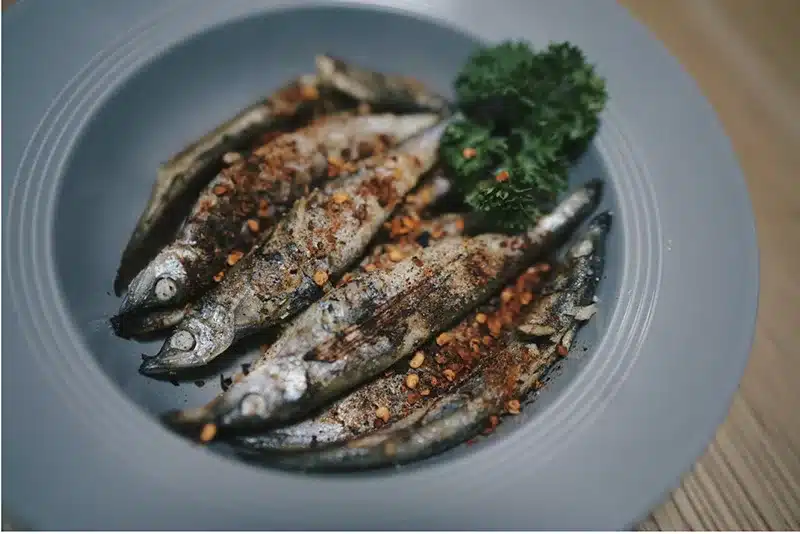
#8. Feijoada à Transmontana (Bean Stew)
Vegetarians, look away! Hailing from Brazil, feijoada is a hearty bean and meat stew. Traditionally, this dish uses various parts of the pig from the snout and the ears to the feet and the rump. Today, the variations might use a variety of preserved meats and different types of beans. Feijoada is an extremely popular dish, especially in places that Portugal colonized, like Mozambique, Cape Verde, and Angola.
The Feijoada à Transmontana is popular in the north of Portugal and includes kidney beans with different meats that might include chorizos, pork, or cow meat. The exact ingredients will vary, but expect to bite into carrots and cabbage. A side of rice helps to soak up all the saucy goodness. It’s a hearty, warm dish that’s perfect for colder days.
Read more like this: One man’s remarkable journey to a fresh start in Portugal
#9. Francesinha (Meat Sandwich)
This dish originates from the beautiful northern city of Porto and roughly translates to “little French girl.” It slightly resembles a Croque Monsieur, although it’s Portugal’s beefed and sauced-up version. The dish typically features bread, ham, linguiça, and steak, and then covered with cheese. This decadent stacked sandwich is then smothered in a sauce made of beer, wine, port, spices, and tomatoes. Some restaurants kick things up by adding an egg and a side of French fries. It’s a hefty dish that will certainly provoke a food coma, so be prepared. However, it’s an ideal remedy after a night of drinking a few too many port wines.
#10. Peixe em Conserva (Preserved Fish)
Throughout Portugal, you’ll find an abundant selection of preserved fish in cute little cans. The shelves of supermarkets are stocked with conservas, as well as fancy-looking and vibrant Lojas das Conservas, or stores of conservas. The conserva stores are lined floor to ceiling, fully dedicated to the delicacies, offering everything from anchovies and cockles to tuna and octopus. Pick your favorite preserved fish and sample it in a variety of flavor combinations from spicy to sweet and everything in between.
This straightforward, simple, and healthy little snack is on many restaurant and wine bar menus, pairing perfectly with a glass of Vinho Verde. An added bonus is that these cans are easy to pack in your suitcase. When you’re craving the tastes of Portugal at home, simply peel open a can to be transported back to the land of cobblestone streets, tiled buildings, and ocean air.
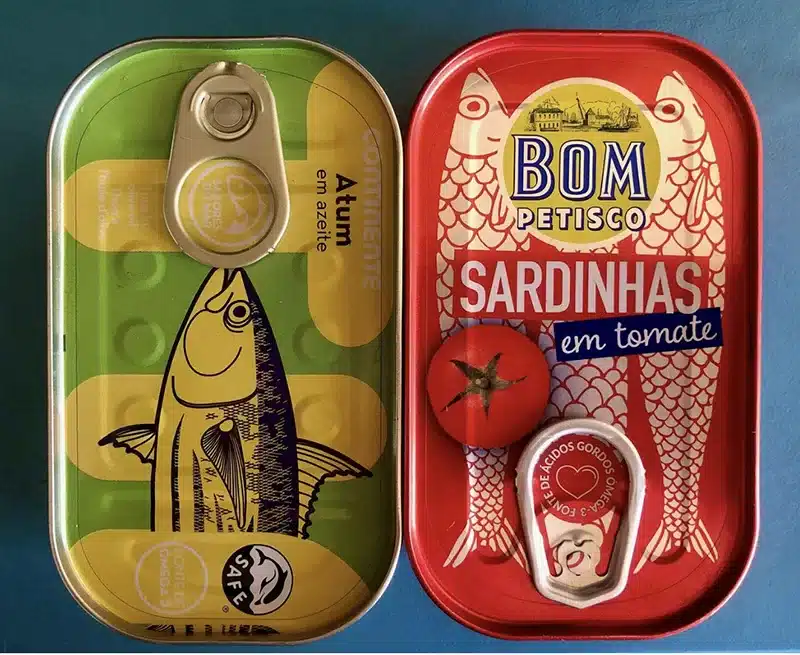
#11. Polvo à Lagareiro (Octopus with Olive Oil and Potatoes)
There are many ways to enjoy octopus in Portugal, but this traditional dish allows the flavors and texture of the octopus to shine. This rendition’s roots are from the Beiras region in northern Portugal, bordering Spain. Polvo à Lagareiro features roasted octopus doused in olive oil with a generous amount of fresh garlic and roasted potatoes. It’s simple, it’s straightforward, and it’s scrumptious. If this doesn’t ring your bell, have no fear, you’ll find plenty of variations stemming from this recipe in various restaurants all over the country.
Read more like this: Best Foods in the World
#12. Petiscos (Tapas / Small Bites)
Deriving from the Portuguese verb to snack “petiscar,” Petiscos are essentially Portuguese-style tapas. Oftentimes, these little starters are enjoyed before a larger meal. These little bites are also the ideal accompaniment to a hefty glass of local wine. The list of finger foods includes everything from local and fresh cheeses to Iberian ham, marinated olives, preserved fish, pickled vegetables, and fava beans. The buck doesn’t stop there, though; you can also enjoy deep-fried green beans, grilled prawns, freshly shucked oysters, croquettes, and sliced sausages. It’s like a build-your-own snack menu of tasty bites. Charcuterie board lovers will be thrilled!

#13. Cozido à Portuguesa (Boiled Meat Stew)
Meat lovers, this one’s for you. This old-school, hearty, and traditional dish is typically made in one pot. This recipe dates way back to earlier times when the goal was to feed as many people as possible while also not letting anything go to waste. All parts of the animal were used, as well as any abundant vegetables—it’s your kitchen-sink stew of sorts.
Today, this meat lovers’ stew is packed with a variety of meats, potatoes, beans, and vegetables. Each region has its variations, and pork is predominantly the featured meat. However, you’ll find all kinds of different interpretations on different restaurant menus! The Azores might just have the most unique rendition because they slow-cook this pot underground, heated by volcanic steam.
Good Food, Good Weather, and Good Times Await in Portugal
Portugal is home to tantalizing dishes and an abundance of fresh seafood. Hopefully, you’ve found some dishes on our list that pique your interest! And this is just a small selection of what you can enjoy in this land of warm weather and great wine. In fact, there are over 250 unique wine varietals in Portugal, which means you’ll have endless opportunities to discover the ultimate pairings to lunches, dinners, and Petiscos. Come discover the variety of Portuguese cuisine and why this country is so passionate about its food! There is a little something for every palate. And, if all else fails, order another Pastel de Nata or bottle of Portuguese wine!
Read more like this: Most Popular Expat Cities in Portugal
Portuguese Food: A Flavorful Journey Awaits!
Craving authentic travel experiences and bold flavors? Stay in the know with Escape Artist! Discover the best of Portuguese food, international cuisine, expat living, lifestyle tips, and global adventures. From Lisbon’s markets to Algarve’s coastal delights—your taste of Portugal starts here. Subscribe now and never miss a bite!
FAQ: Portuguese Foods
1. What is Portuguese food?
Portuguese food is a flavorful and diverse cuisine known for its use of fresh seafood, olive oil, garlic, and spices. It blends Mediterranean and Atlantic influences, offering hearty dishes, rustic flavors, and a rich culinary heritage.
2. What are the most popular traditional Portuguese food?
Some iconic dishes include bacalhau à Brás (salted cod), caldo verde (green soup), francesinha (Porto sandwich), and pastel de nata (custard tart).
3. What to eat in Portugal?
Must-try foods in Portugal include bacalhau (salted cod), pastel de nata (custard tart), caldo verde (green soup), sardines, francesinha (a layered meat sandwich), and grilled piri-piri chicken.
4. What do people eat in Portugal?
The Portuguese diet includes a variety of seafood, pork, rice, stews, and bread. Meals often start with soup, followed by meat or fish, and end with dessert or fruit. Locals also enjoy regional wines and strong espresso.
5. What is traditional Portuguese food?
Traditional Portuguese food features dishes like cozido à portuguesa (meat and vegetable stew), arroz de marisco (seafood rice), feijoada (bean stew), and alheira (smoked sausage). Each region has its own unique specialties rooted in local ingredients and history.
About the Author
Elizabeth McGonagle is a travel and food writer currently based in Lisbon, Portugal. She’s been lucky enough to live in five countries and is passionate about exploring different landscapes, learning languages, and discovering new cuisines.
Contact Author
"*" indicates required fields
Stay Ahead on Every Adventure!
Stay updated with the World News on Escape Artist. Get all the travel news, international destinations, expat living, moving abroad, Lifestyle Tips, and digital nomad opportunities. Your next journey starts here—don’t miss a moment! Subscribe Now!
